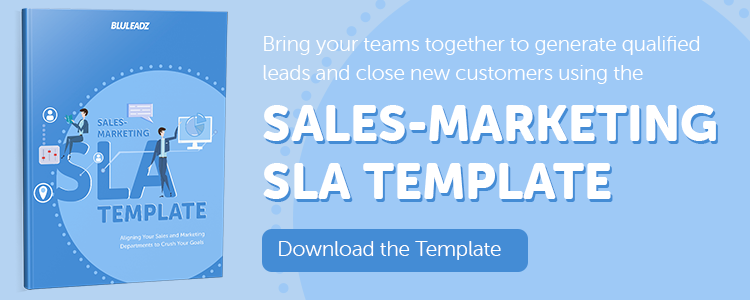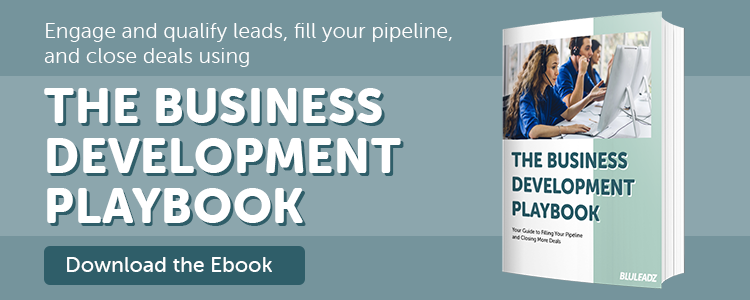Business Development Process Steps
- 1. Identify - identifying the right leads
- 2. Connect - connecting with the right leads
- 3. Discover - discovering the root cause and impact of the lead's problems
- 4. Commitment - scheduling a meeting, gaining their commitment of time
A common problem that plagues organizations is the disconnect that exists between marketing and sales.
Marketing teams may be working their hardest to generate interest so they can draw in leads and prospects for the sales team.
However, sales teams may feel like they are toiling most of the day prospecting and lead qualifying when they should be working on closing deals. Or they're struggling to close marketing qualified leads (MQLs) that are not good fits.
This is difficult for the two departments to remedy on their own because sales may say that the leads coming in aren't qualified, and marketing may say that sales team members just need to work on closing techniques.
The metrics may look good to marketing teams, but there is no system to distinguish high quality leads from the low quality leads. Even worse, there is no visibility into where the disconnect is happening.
The solution? Create and implement business development processes into your marketing and sales process to solve this.
What Is a Business Development Process?
A business development process refers to the activities that take place at the beginning of the sales cycle. These activities include prospecting, initial engagement, customer research, and lead qualification.
The business development process helps warm up leads or prospects for future purchasing decisions.
It is essential to have a process dedicated to business development so you can capture and nurture prospects at the beginning stages of the buyer’s journey who are not ready for sales outreach yet.
This allows sales reps to focus their attention on closing deals instead of misusing their time on a phone call.
A well-executed business development process boosts the amount of sales your reps close.
What You Need Before Creating a Business Development Process
Here are some of the essential components you need before you can launch a successful business development process.
A Good Lead Qualification System
The lead qualification system represents the way leads move through the stages of the buyer's journey. Clearly defined processes for qualifying leads are needed for your business development process to be effective.
For instance, you need to know what qualifies a lead, when a lead becomes a prospect, and when a prospect becomes ready for a sales meeting with your account executives (AEs).
Sending prospects to sales reps or AEs when they haven't been properly educated on products or services can cause them to waste precious time they could be using on targeted prospects who are more likely to convert.
The Right CRM Platform
Your CRM should be able to support your business development reps' (BDRs) workflows and methods to make the process more streamlined. You don't want your BDRs spending time on additional administrative tasks that don't contribute to a sale.
A combination of the right sales software and CRM allows BDRs to gather lead information and carry out prospecting activities efficiently.
An Easily Accessible Content Management Portal
Business development representatives often make use of content and collateral in order to qualify leads and educate prospects. The content they need may often exist in a library that acts more as a silo, which causes BDRs to waste their time searching for the content they need.
A central content management system (CMS) database with approved content that is clearly labeled, classified, and filed away makes it easy for your team to find the resources they need that can help impact a prospect's buying decision.
A Business Development Team
This essential component may seem quite obvious. What is less obvious is who you should look for to become a part of your business development team.
You have three options:
- Build from within
- Hire new professionals
- Outsource
No matter which option you choose for your business development, you should search for BDRs that:
- Have a growth-mindset
- Are coachable
- Are collaborative
- Are self-starters
- Manage their time wisely
- Think critically
- Actively listen
Train your BDRs well and don't rush the training process. Provide them with hands-on training and feedback, and allow them to practice.
Playbooks and sales battlecards can help your new recruits get up to speed on your organization quickly and can serve as a quick reference for them on calls.
Easy-to-Use Email Templates
Email is a primary form of outreach, next to phone calls. Crafting emails takes time and effort that could be better spent on more important tasks.
Speed this process up for BDRs by providing them with great email tools that include a library of attractive templates. In some cases, your CRM will come fully quipped with everything you need to draft, schedule, and send attractive emails to leads and prospects.
Conversational Scripts for BDRs to Reference
Conversational scripts are a great resources for BDRs to use so they can learn how to lead conversations with prospects.
Most often, your potential clients won't have time to talk for lengthy periods of time. Your BDRs need to know how to get through a conversation quickly while maintaining a steady pace that still allows them to hit all of the necessary points.
Conversational call scripts can help them do just that.
Sales Analytics to Track Progress
Sales analytics provide great insight into what works and what doesn't.
Use sales reporting to provide your BDRs with data that informs them on critical aspects of each deal, like which sales materials are the most effective to align with buyer personas throughout different stages in the buyer's journey.
Collaboration Between Marketing and Sales
Business development bridges the gap between marketing and sales. The ongoing dialogue between both departments is needed for improvement and continuous growth.
A good practice is to develop a method for feedback. Both teams should provide feedback to each other about the nuances and challenges related to their roles.
Sales-Marketing Service Level Agreements (SLA)
Along with the collaborative efforts of sales and marketing, an SLA should be put in place.
A sales-marketing service level agreement (SLA) is a contract that sets specific deliverables that one party has agreed to provide the other party.
Between sales and marketing departments, an SLA includes critical metrics, like marketing goals and the sales activities that uphold or support those goals. This document is used as a commitment between the two departments to support each other based on numerical goals.
A Prospect Fit Matrix
A prospect fit matrix is a cheat sheet that helps you to evaluate who your product fits, who it doesn't fit, and who it could possibly fit.
The matrix is typically laid out in a grid formation with three rows and three columns. Some of the qualifies are good, fit, neutral, and bad fit along one side. And the other side has qualifiers that are interested, neutral, and not interested.
Some of the items inside the matrix are contact, contact immediately, nurture, and remove prospect. This resources provides an if-then scenario for qualifying prospects based on their needs and their fit.
The 4 Steps of Your Business Development Process
Business development becomes simple and methodical when you adopt steps for your team to follow. Here are the four steps you can follow to start serving up prospects that close to your sales team.
1. Identify: Identifying the Right Leads
Determining who your right leads are starts with assessing your website analytics.
Which visitors have been to your site more than once? What content have they engaged with? Have they downloaded any of your offers? Do they frequently open and engage with emails from your drip campaigns?
If the answer is yes, then you know they have some interest in what you do and what you offer.
Assess all of the relevant data you need within your marketing automation software to find the right leads to start connecting with.
2. Connect: Connecting With the Right Leads
This is the second step where your BDR kicks off the sales process by connecting with leads via phone call or email.
The connection portion of the business development process is when the BDR begins to build a relationship with a lead. It is a casual conversation where BDRs can collect information and answer any questions the lead may have.
During this step, they may also begin offering them collateral or content that provides them with value.
3. Discover: Discovering the Root Cause and Impact of the Lead's Problems
Next, BDRs ask value-based questions in order to identify the lead's true pain points and the source of those pain points. This helps them to better understand how to position your products and services for each individual customer.
It also allows BDRs to weed out unqualified leads from qualified leads.
4. Commitment: Scheduling a Meeting and Gaining Their Commitment of Time
After business development reps determine the product fit for prospects, they ask to set up a meeting between the lead and a sales closer. The lead is then passed on to sales for the sales meeting where a sales rep is responsible for closing the deal.
A commitment isn't always made immediately after discovery calls. Sometimes it takes some follow up and nurturing before a lead will schedule a meeting.
It is likely that your organization already applies some of the elements involved in the business development process. The more you refine your processes and expectations throughout the business development processes and the more you train your teams on these processes, the more qualified leads your BDRs can pump out for sales reps to close.
Invest your time into business development and reap the benefits, such as improved efficiency, greater returns on your investment in sales activities, and, most notably, an increase in customers and revenue.



Erika Giles
Erika is a Marketing Copywriter at Bluleadz. She is a huge fan of houseplants and podcasts about conspiracy theories. She spends most of her free time reading, writing, and enjoying the outdoors.